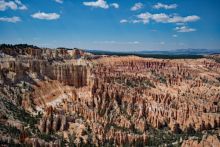Geoscience Currents transmit snapshots of the many facets of the geoscience profession, in-depth case studies of how geoscience is applied, factsheets that provide rigorous introductions to a range of geoscience topics, workforce trends, and career paths.
Partner with us to help support well-informed public policy and decision making with expert, impartial geoscience information. Visit our Sponsorships page for more information or email sponsorships@americangeosciences.org.
Displaying 11 - 20 of a total of 34 items

May 19, 2017
Surface and subsurface mapping of lahar and lahar runout deposits from Glacier Peak volcano has contributed important geologic information for land-management planning and emergency preparedness in the lower Skagit Valley.
Defining the Problem
Active volcanoes, such as Glacier Peak (Fig. 1), pose...

May 19, 2017
Under pressure to restrict aggregate operations, county leaders in Tooele, Utah developed an ordinance to protect the stone, gravel, and sand industry as well as the environment.
Between 1990 and 2000, the population of Tooele, Utah, increased 51.3 percent to 40,735. As demand for construction and...

May 19, 2017
In Garfield County, an area of multiple land uses, geologic maps show the location and quality of the sand and gravel resources. Planners, citizens, and resource developers use this information to locate and evaluate potential deposits and make informed land-use choices.
Defining the Problem
As...

May 19, 2017
Landslide hazard maps based on geologic maps are a tool for local government officials, planners, developers, engineers, insurance companies, lending institutions, and landowners to assess the risk and take appropriate actions.
Defining the Problem
Damaging landslides occur even in vertically...

May 19, 2017
Geologic maps can help to show which areas may be more prone to landslides and therefore directly assist in making optimum engineering design choices.
Defining the Problem
U.S Highway 85 and ND Highway 22, along with numerous county roads, buildings, pipelines, and power lines, have been...

May 19, 2017
In California, detailed modern geologic maps are fundamental for evaluating how susceptible an area is to earthquake-induced landslides.
Defining the Problem
The geologic history of the Oakland, California, area has produced steep hillsides and unstable rock and soil that generate damaging...

May 19, 2017
The Sudbury region of Ontario is rich in metallic ores. Underground mining operations at the 15 active mines of Inco Ltd. and Falconbridge Ltd. in Sudbury currently produce 51,000 tons of ore per day [note: these figures are from the late 1990s], and five other mines within 500 km of Sudbury...

May 19, 2017
Geologic maps have provided the key to finding new gold deposits in Nevada.
Defining the Problem
The western states contain many gold deposits (Fig. 1), and a zone of faulted sedimentary and igneous rocks in northeastern Nevada, known as the “Carlin” trend, is the most productive region in the...

May 19, 2017
Hurricanes bring not only intense rainfall, but also high winds and flooding. This flooding is powered by the hurricane storm surge: a rise in coastal sea level caused by lowered barometric pressure and by wind blowing the ocean onto the land. The result is that waves and currents affect areas that...

May 19, 2017
Geologic maps are useful in identifying areas that may be affected by post-wildfire debris flows. Land-use planners use these maps to identify potential hazards in areas that are proposed for development and to develop mitigation strategies. The maps can also focus post-wildfire emergency planning...
Pages
Upcoming Webinars


